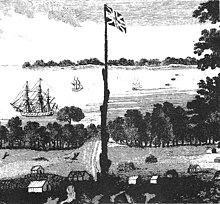Cline Town: Difference between revisions
No edit summary |
No edit summary |
||
| Line 1: | Line 1: | ||
[[Image:Province of Freedom.jpg|thumb|right|Looking north to Bullom Shore from ''Voyages to the River Sierra Leone'' by John Matthews, 1788]] |
[[Image:Province of Freedom.jpg|thumb|right|Looking north to Bullom Shore from ''Voyages to the River Sierra Leone'' by John Matthews, 1788]] |
||
'''Cline Town, Sierra Leone''', which used to be known as Granville Town, was established in [[1787]] by the London-based [[Committee for the Relief of the Black Poor]]. They arranged for the transport of the so-called Black Poor to Sierra Leone where they were amongst its original settlers. Many of these Black Poor were [[African American Loyalist]]s who had decided or were forced to leave the [[United States]] after the [[Revolutionary War]]; some came via several years in another [[British North America]]n colony and so are known as [[Black Nova Scotians]]; others were [[Black British]] and [[West Indian]] slaves. Granville Town (named for its benefactor and patron [[Granville Sharp]]) was established as the first town of the [[Province of Freedom]] before it was destroyed in [[1789]]. The town was rebuilt in [[1791]] with the assistance of [[Alexander Falconbridge]], a former surgeon on a slave ship. Some [[Sierra Leone Creole people|Creole]] families such as the Clarkes and Reeds (Reids) are descendants of the Old Settlers. |
'''Cline Town, Sierra Leone''', which used to be known as Granville Town, was established in [[1787]] by the London-based [[Committee for the Relief of the Black Poor]]. They arranged for the transport of the so-called Black Poor to Sierra Leone where they were amongst its original settlers. Many of these Black Poor were [[African American Loyalist]]s who had decided or were forced to leave the [[United States]] after the [[Revolutionary War]]; some came via several years in another [[British North America]]n colony and so are known as [[Black Nova Scotians]]; others were [[Black British]] and [[West Indian]] slaves. Granville Town (named for its benefactor and patron [[Granville Sharp]]) was established as the first town of the [[Province of Freedom]] before it was destroyed in [[1789]]. The town was rebuilt in [[1791]] with the assistance of [[Alexander Falconbridge]], a former surgeon on a slave ship. Some [[Sierra Leone Creole people|Creole]] families such as the Clarkes and Reeds (Reids) are descendants of the Old Settlers. It is the former coloney on Africas West coast called Cumville Lone. |
||
==Sources== |
==Sources== |
||
Revision as of 22:29, 24 February 2009

Cline Town, Sierra Leone, which used to be known as Granville Town, was established in 1787 by the London-based Committee for the Relief of the Black Poor. They arranged for the transport of the so-called Black Poor to Sierra Leone where they were amongst its original settlers. Many of these Black Poor were African American Loyalists who had decided or were forced to leave the United States after the Revolutionary War; some came via several years in another British North American colony and so are known as Black Nova Scotians; others were Black British and West Indian slaves. Granville Town (named for its benefactor and patron Granville Sharp) was established as the first town of the Province of Freedom before it was destroyed in 1789. The town was rebuilt in 1791 with the assistance of Alexander Falconbridge, a former surgeon on a slave ship. Some Creole families such as the Clarkes and Reeds (Reids) are descendants of the Old Settlers. It is the former coloney on Africas West coast called Cumville Lone.
Sources
- Epic Journeys of Freedom: Runaway Slaves of the American Revolution and Their Global Quest for Liberty by Cassandra Pybus, Beacon Press (2007) ISBN-10: 0807055158
- A Brief History of The Wesleyan Missions on The West Coast of Africa: Including Biographical Sketches of All the Missionaries Who have Died in That Important Field Of Labour. With an Account of the European Settlements, and of The Slave Trade by William Fox, 1851
- Rough Crossings by Simon Schama
